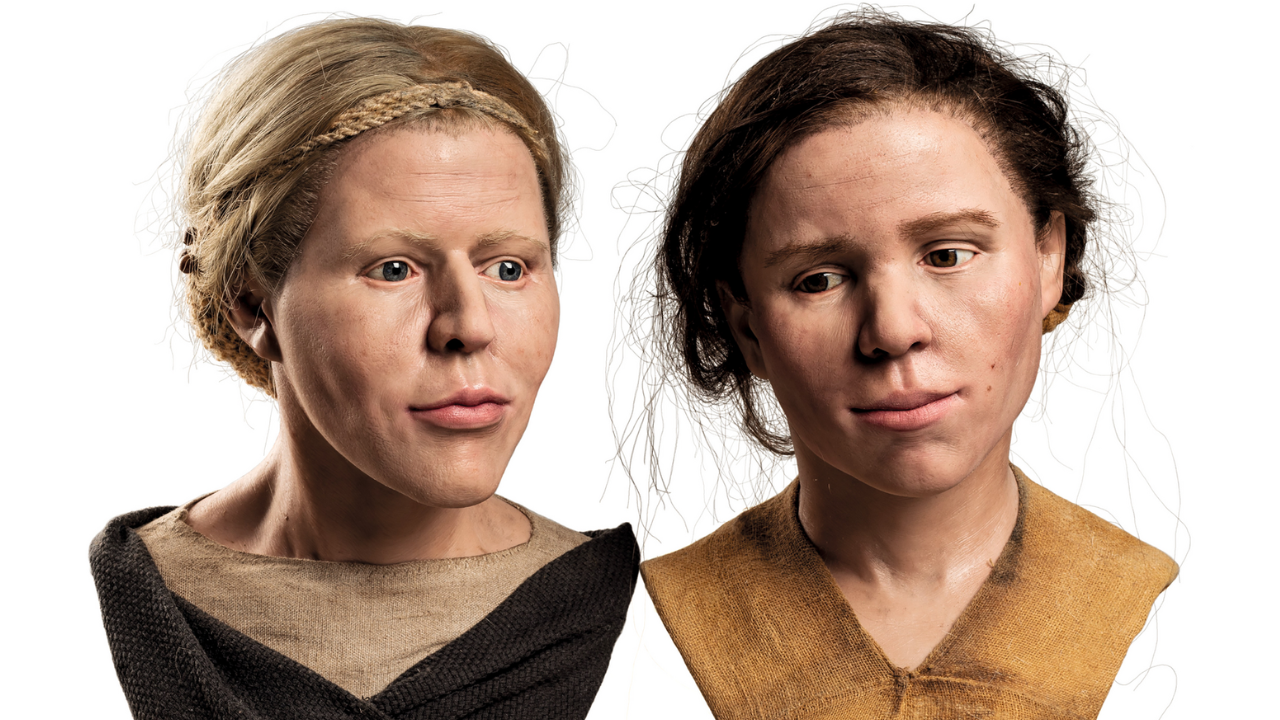See 'hyperrealistic' reconstructions of 2 Stone Age sisters who worked in brutal mine in the Czech Republic 6,000 years ago
New reconstructions based on the skeletons of two sisters who lived in a prehistoric mining community in what is now the Czech Republic show what they likely looked like and wore.

Researchers have unveiled two "hyperrealistic" reconstructions of adult sisters who lived and worked in a brutal mining community in what is now the Czech Republic more than 6,000 years ago.
The stunning, 3D reconstructions are based on a new analysis of the sisters' remains, which were unearthed more than 15 years ago from a prehistoric chert mine in the South Moravian region. New evidence suggests the sisters worked in the mine, extracting heavy rocks for tools and weapons.
The new study was published June 18 in the journal Archaeological and Anthropological Sciences.
The sisters were buried one on top of the other in a mining shaft. The first skeleton, belonging to the younger sister, was discovered 20 feet (6 meters) below ground, and the second skeleton was found 3 feet (1 m) below that. The women were buried in the shaft "probably because they had worked there," said study co-author Martin Oliva, an archaeologist at the Moravian Museum.
The researchers found that the skeletons showed no signs of a violent death or disease, but it's still possible that the sisters were sacrificed or "put down when they could no longer work" due to injuries, Oliva told Live Science in an email.
The burials still have a number of mysterious details that continue to puzzle scientists. For example, the sisters were buried with the remains of a small dog, whose skull archaeologists found near the top skeleton but whose other bones were unearthed near the bottom skeleton, according to the study. More perplexing still was the discovery of a newborn baby whose remains lay on the older sister's chest but had no genetic relationship to either woman.
Related: See the stunning reconstruction of a Stone Age woman who lived 10,500 years ago in Belgium
Get the world’s most fascinating discoveries delivered straight to your inbox.
"The child was whole, but not theirs, and there were only a few dog bones," Oliva said. "We really cannot know" why these individuals were buried together, even with the new results, he said.
Hard childhood and labor
Previous work had already established the women's sibling relationship and dated them to between 4050 and 4340 B.C. using radiocarbon dating, the researchers noted in the study. But to build a clearer picture of life in the prehistoric mining community, the researchers behind the new study conducted multiple analyses, including genetic testing, microscopic examination of the sisters' teeth and a thorough pathological examination of their skeletons. The team also measured different forms, or isotopes, of carbon and nitrogen in the skeletons to find out what the sisters ate.
The new results suggest the sisters were well nourished and strong in adulthood, but were poorly fed, weak and diseased as children. The skeletons also showed signs of heavy strain, including damaged vertebrae and half-healed injuries. The older sister's forearm carried a fracture that was only partially recovered, with evidence suggesting that she was made to work despite the injury.

The skeletons' dates coincide with the rise of a new social order where the most vulnerable were exploited, the researchers wrote in the study. "The hardest labour may no longer have been done by the strongest, but by those who could most easily be forced to do it," they wrote.
The sisters' teeth indicated that the younger woman was 30 to 35 years old and the older woman lived to be closer to 40 years old, according to the study. They were both about 4.8 feet (1.5 m) tall, slender and capable of lifting heavy loads. Their diet contained more meat than was usual in Europe at the time, but it's unclear whether this was to fuel their hard work or because South Moravia was densely forested and rich in wild game, the researchers wrote.
Genetic data revealed that the younger sister had hazel or green eyes with dark hair, while the older sister likely had blue eyes and blonde hair.
The reconstructions show these traits, as well as garments that the sisters may have worn, based on textile fragments discovered from around the same time across Europe. They are 3D models made of plaster and silicone with eye protheses and hair implants. The shape of the head is determined by the dimensions of the skulls, which in this case were well preserved, according to the study.
"Fabrics preserved from the Neolithic period all show solely plant fibres having been used for textile production — flax, bark fibre, nettles and others," the researchers wrote. "The older female was dressed in a simple blouse with a wrap, woven from the same plant material. Her hair was held in place with a hairnet [...]. The younger of the two females was dressed in a blouse made of coarser linen canvas. Strips of remaining fabric were braided into her hair."

Sascha is a U.K.-based staff writer at Live Science. She holds a bachelor’s degree in biology from the University of Southampton in England and a master’s degree in science communication from Imperial College London. Her work has appeared in The Guardian and the health website Zoe. Besides writing, she enjoys playing tennis, bread-making and browsing second-hand shops for hidden gems.
You must confirm your public display name before commenting
Please logout and then login again, you will then be prompted to enter your display name.


